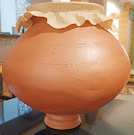
Traditional Goan Ornaments Each gold and stone-studded handcrafted ornament of Goa holds its own special place in the bridal jewellery and festive attire of Goan families. The Goan bridal 'CHUDO' The chudo, a set of bangles made of green glass and gold, is worn by Hindu and as well as some Catholic brides in Goa, carrying forward a shared tradition. The ornaments are in the form of headgear, bangles, neckpieces, armbands (bazuband) , nose pins or rings (naath) and anklets like the silver payzan and vedê. Before Goa’s liberation, when girls typically married young and had fewer opportunities, these ornaments were often gifted by parents as a form of financial security. Traditionally, each piece was crafted locally by skilled goldsmiths, although some recent designs have also begun to be machine-made. Over the years, the influence of more intricate jewellery designs from the neighbouri...


